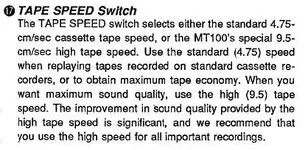miroslav
Cosmic Cowboy
It's just math here.
Yeah, the manual says the high speed is 9.5 cm/second, which is 3.75 ips. So now we know where you got that bogus 9 ips figure.
I guess someone had trouble with his math!

It's just math here.
Yeah, the manual says the high speed is 9.5 cm/second, which is 3.75 ips. So now we know where you got that bogus 9 ips figure.

It's not so much a question of banning anyone...but this is either intentional trolling or very confused BS...neither of which falls under the "free speech" umbrella, IMO, when it's continual.
Any time there is a person who comes here to ask questions...and then proceeds to reject all answers that the rest of the world agrees on...you gotta wonder which of the above two explanations apply.
I think it's trolling...though it may be driven by some confused understanding.
Here is a 48k hd mic from cell phone recording. I think Samsung dose a really good job at recreating the detail of these instruments played. I think they have the best alogrithm for doing this. But even so. They manage to recrete the exact detail for what the instruments truly sound like in 48k audio. There is a certian meatyness that is missing.
Life in Peril by ryankm | Ryan Murphy | Free Listening on SoundCloud
 ...you're talking about "detail of the instruments"...but you don't notice how out of tune everything is, and the overload distortion that is so obvious in your audio clips.
...you're talking about "detail of the instruments"...but you don't notice how out of tune everything is, and the overload distortion that is so obvious in your audio clips.
Wow......you're talking about "detail of the instruments"...but you don't notice how out of tune everything is, and the overload distortion that is so obvious.
Now you definitely remind me of a troll we had here not too long ago...he would post clips of his awful, out of tune singing and crazy screaming...and constantly ask if he was improving, but it was always the same thing, over and over...and in the end, it turned out he was trolling other sites with the same nonsense, just to get a rise out of people.
Anyway...good luck with your music, with your 384 kHz conversions, and your "9 ips" high quality cassette mixing.
You're onto to something that no one else has discovered.

Ryan Murphy said:strx40 AsRock Taichi with realtek 1220 audio codec
Codec: Realtek ALC1220
Address: 0
AFG Function Id: 0x1 (unsol 1)
Vendor Id: 0x10ec1220
Subsystem Id: 0x18492220
Revision Id: 0x100101
No Modem Function Group found
Default PCM:
rates [0x5f0]: 32000 44100 48000 88200 96000 192000
bits [0xe]: 16 20 24
formats [0x1]: PCM
Ryan Murphy said:Do you rea;llize that i have bewen trying to tell you people that the mic input analog to digital convert audio on this mobo are in fact bull shit?

it says 9. I use inch not metric.

The only difference between inches and centimeters is a factor of 2.54. This is an exact conversion.
in. x 2.54 = cm
cm / 2.54 = in.
rob aylestone said:I'm firmly off the opinion that I cannot tell 44.1 from 48KHz, so there is no point recording twice as much data I cannot hear by using 96!
ecc83 said:Except, OUR inch (good riddance!) was not quieeeet the same as the US inch.
I'm not familiar with that one. My line of work requires conversion between metric and imperial units for the most part.
The metric system is an attempt to replace a variety of different measuring systems with an international standard, but imperial units are still widely used and the US tends to do their own thing. We know what a ton is, but there's the long ton, the short ton and the metric tonne which are all different. US gallon is not the same as the imperial gallon. Whitworth threads, etc...
At least with metric, a litre only means one thing.
